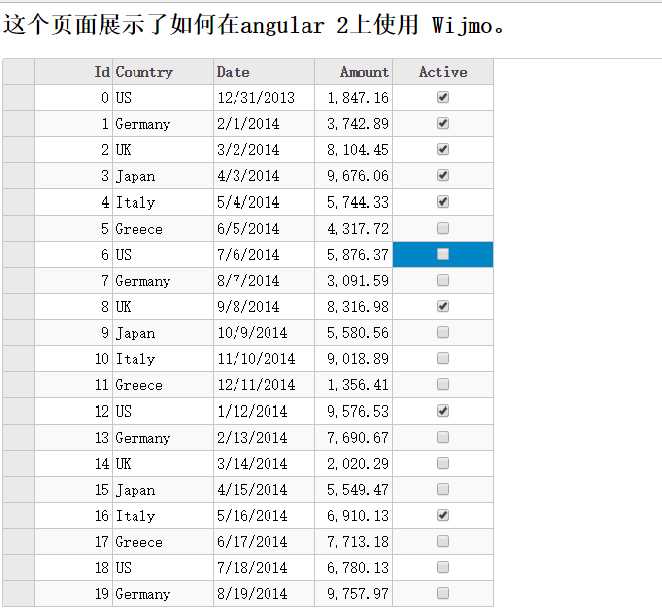标签:item items styles rem 目的 his 移动端 core move
中秋之际,Angular 团队发布 Angular 2 正式版,一款不错的图表控件Wijmo当天宣布支持 。
Angular 2移除和替代了 Angular 1.X 中的 directives, controllers,modules, scopes,几乎移除了 1.X 中的核心concepts 。 相比于之前的版本,简单地说主要有:
Angular 2 真的非常优秀。
Wijmo 当天支持 Angular 2,其所有控件作为组件管理,也更加模块化和高效。
相信你已经学习了 Angular 2 的Quickstart,如果没有,没关系,因为下面的讲解非常详细。源代码已经上传 。
在此之前,你需要
$ mkdir wj-ng2-flexgrid
$ cd wj-ng2-flexgrid我们需要下面 3 个配置文件。
->>package.json
{
"name": "wj-ng2-flexgrid",
"version": "1.0.0",
"scripts": {
"start": "tsc && concurrently \"tsc -w\" \"lite-server\" ",
"lite": "lite-server",
"tsc": "tsc",
"tsc:w": "tsc -w"
},
"licenses": [
{
"type": "MIT",
"url": "https://github.com/angular/angular.io/blob/master/LICENSE"
}
],
"dependencies": {
"@angular/common": "~2.1.1",
"@angular/compiler": "~2.1.1",
"@angular/core": "~2.1.1",
"@angular/forms": "~2.1.1",
"@angular/http": "~2.1.1",
"@angular/platform-browser": "~2.1.1",
"@angular/platform-browser-dynamic": "~2.1.1",
"@angular/router": "~3.1.1",
"@angular/upgrade": "~2.1.1",
"angular-in-memory-web-api": "~0.1.13",
"core-js": "^2.4.1",
"reflect-metadata": "^0.1.8",
"rxjs": "5.0.0-beta.12",
"systemjs": "0.19.39",
"zone.js": "^0.6.25"
},
"devDependencies": {
"@types/core-js": "^0.9.34",
"@types/node": "^6.0.45",
"concurrently": "^3.0.0",
"lite-server": "^2.2.2",
"typescript": "^2.0.3"
}
}->> tsconfig.json
{
"compilerOptions": {
"target": "es5",
"module": "commonjs",
"moduleResolution": "node",
"sourceMap": true,
"emitDecoratorMetadata": true,
"experimentalDecorators": true,
"removeComments": false,
"noImplicitAny": false
}
}->> systemjs.config.js
/**
* System configuration for Angular samples
* Adjust as necessary for your application needs.
*/
(function (global) {
System.config({
paths: {
// paths serve as alias
‘npm:‘: ‘node_modules/‘
},
// map tells the System loader where to look for things
map: {
// our app is within the app folder
app: ‘app‘,
// angular bundles
‘@angular/core‘: ‘npm:@angular/core/bundles/core.umd.js‘,
‘@angular/common‘: ‘npm:@angular/common/bundles/common.umd.js‘,
‘@angular/compiler‘: ‘npm:@angular/compiler/bundles/compiler.umd.js‘,
‘@angular/platform-browser‘: ‘npm:@angular/platform-browser/bundles/platform-browser.umd.js‘,
‘@angular/platform-browser-dynamic‘: ‘npm:@angular/platform-browser-dynamic/bundles/platform-browser-dynamic.umd.js‘,
‘@angular/http‘: ‘npm:@angular/http/bundles/http.umd.js‘,
‘@angular/router‘: ‘npm:@angular/router/bundles/router.umd.js‘,
‘@angular/forms‘: ‘npm:@angular/forms/bundles/forms.umd.js‘,
‘@angular/upgrade‘: ‘npm:@angular/upgrade/bundles/upgrade.umd.js‘,
// other libraries
‘rxjs‘: ‘npm:rxjs‘,
‘angular-in-memory-web-api‘: ‘npm:angular-in-memory-web-api/bundles/in-memory-web-api.umd.js‘
},
// packages tells the System loader how to load when no filename and/or no extension
packages: {
app: {
main: ‘./main.js‘,
defaultExtension: ‘js‘
},
rxjs: {
defaultExtension: ‘js‘
}
}
});
})(this);安装依赖包。
在当前目录下,运行
$ npm install 所有依赖包会全部下载下来,如果命令行有警告,可以忽略 。这些警告表示包里没有repository field,这些field仅仅用于一些包信息。
如果因为某些原因包无法下载,那可以使用淘宝的镜像 cnpm。这个镜像会每隔10分钟和官方同步一次。
安装结束,会在项目的根目录下多出一个node_modules 文件夹,它实在是太大了 !
现在您需要将 \wijmoEnterprise\Samples\TS\Angular2\FlexGridIntro\FlexGridIntro\node_modules\wijmo 文件夹拷贝到当前项目中的 node_modules 文件夹。这些文件用来将wijmo包包装为 es6 模块。
好了,现在的准备工作已经完成了,您可以开始创建wijmo & Angular 2 的应用了。
玩Angular 2,首先我们需要Angular 2的脚手架。
现在来看看我的文件目录,并逐一解释。
└─ wj-ng2-flexGrid/ ······························· 项目所在目录
├─ node_modules/ ······························· 项目依赖包
├─ app/ ········································ 应用程序子目录
│ ├─ components/ ······························ 组件目录
│ │ ├─ app.component.html ···················· 根组件app.Component模板
│ │ └─ app.conponent.ts ······················ 根组件app.Component
│ ├─ services/ ································ 服务目录
│ │ └─ data.service.ts ······················· 数据服务 data.Service
│ ├─ app.module.ts ···························· 根模块app.module
│ └─ main.ts ·································· Angular 引导文件
├─ scripts/ ···································· 外部js 目录
│ ├─ definition/ ······························ wijmo 模块定义目录
│ └─ vendor/ ·································· wijmo 脚本目录
├─ styles/ ····································· 样式目录
├─ index.html ·································· 应用宿主页面
├─ package.json ································ npm 依赖列表
├─ systemjs.config.js ·························· systemJS 配置
├─ tsconfig.js ································· TypeScript 配置
└─ readme.md ··································· 程序说明
这看起来似乎比较复杂,但是却很有条理。
在宿主页面中,除了Angular 2中必须的组件,还需要引入Wijmo js脚本。
<html>
<head>
<meta charset="UTF-8">
<title>使用 Angular 2 来创建FlexGrid控件</title>
<!--angular 2 模块开始 -->
<!--用于填充旧版浏览器-->
<script src="node_modules/core-js/client/shim.min.js"></script>
<script src="node_modules/zone.js/dist/zone.js"></script>
<script src="node_modules/reflect-metadata/Reflect.js"></script>
<script src="node_modules/systemjs/dist/system.src.js"></script>
<!--systemjs 配置开始-->
<script src="systemjs.config.js"></script>
<!--wijmo 模块开始-->
<script src="scripts/vendor/wijmo.min.js"></script>
<script src="scripts/vendor/wijmo.grid.min.js"></script>
<link rel="stylesheet" href="styles/wijmo.min.css">
<script src="scripts/vendor/wijmo.angular2.min.js"></script>
<!--mine-->
<script>
System.import(‘./app/main‘).catch(function(err){ console.error(err); });
</script>
</head>
<body>
<!--申明根组件-->
<app-cmp>
Loading ...
</app-cmp>
</body>
</html>这个页面定义完毕,现在来编写一个数据服务。这个数据服务需要被注入到组件中,因此需要引入一个元标记 Injectable 。
data.Service 返回一些国家相关信息的随机数据。
‘use strict‘
import { Injectable } from ‘@angular/core‘;
@Injectable()
export class DataService {
getData(count: number): wijmo.collections.ObservableArray {
var countries = ‘US,Germany,UK,Japan,Italy,Greece‘.split(‘,‘),
data = new wijmo.collections.ObservableArray();
for (var i = 0; i < count; i++) {
data.push({
id: i,
country: countries[i % countries.length],
date: new Date(2014, i % 12, i % 28),
amount: Math.random() * 10000,
active: i % 4 == 0
});
}
return data;
}
}现在我们编写应用的第一个组件:根组件 app.component ,也是这个程序唯一的组件。
import { Component, Inject } from ‘@angular/core‘;
import { DataService } from ‘../services/data.service‘;
@Component ({
selector:‘app-cmp‘,
templateUrl:‘app/components/app.component.html‘,
})
export class AppComponent{
protected dataSvc:DataService;
data: wijmo.collections.CollectionView;
constructor(@Inject(DataService) dataSvc:DataService){
this.dataSvc = dataSvc;
this.data = new wijmo.collections.CollectionView(this.dataSvc.getData(50));
}
}在这个组件中,需要引入两个元标记。Component, Inject ,还需要注入定义的数据服务data.Service。
在组件app.component.html模板中,
<div class="header">
<h2>
这个页面展示了如何在angular 2上使用 Wijmo。
</h2>
</div>
<div>
<wj-flex-grid [itemsSource]="data"> </wj-flex-grid>
</div>在这里,仅仅需要引入一个 wj-flex-grid 标记,就可以创建一个 flexgrid控件了,wj-flex-grid 组件是作为一个子组件存在的,在app.module 模块中注入。
itemsSource 绑定一个数据源,这个itemsSource是flexgrid已经封装完成的属性。在 flexgrid 内部是通过 @Input 来完成的。
在根模块中将组件注入
import { NgModule } from ‘@angular/core‘;
import { BrowserModule } from ‘@angular/platform-browser‘;
import { WjGridModule } from ‘wijmo/wijmo.angular2.grid‘;
import { AppComponent } from ‘./components/app.component‘;
import { DataService } from ‘./services/data.service‘;
@NgModule({
imports: [ WjGridModule, BrowserModule],
declarations: [AppComponent],
providers:[DataService],
bootstrap: [AppComponent],
})
export class AppModule { }在这里,需要将引用的所有的组件和模块都要注入进来。
最后是引导程序 main.ts
import { platformBrowserDynamic } from ‘@angular/platform-browser-dynamic‘;
import {enableProdMode} from ‘@angular/core‘;
import { AppModule } from ‘./app.module‘;
enableProdMode();
platformBrowserDynamic().bootstrapModule(AppModule);在根目录下,运行
$ npm start这时,程序会自动打开默认浏览器并渲染页面。
start 命令是执行定义在 package.json 文件中的scripts命令。 会将ts代码编译为原生js,并且会启动一个静态服务器。 这个服务器会检测文件的变化,当发现文件改动,那么会自动编译ts代码。
效果截图。
标签:item items styles rem 目的 his 移动端 core move
原文地址:http://www.cnblogs.com/Leo_wl/p/6058255.html